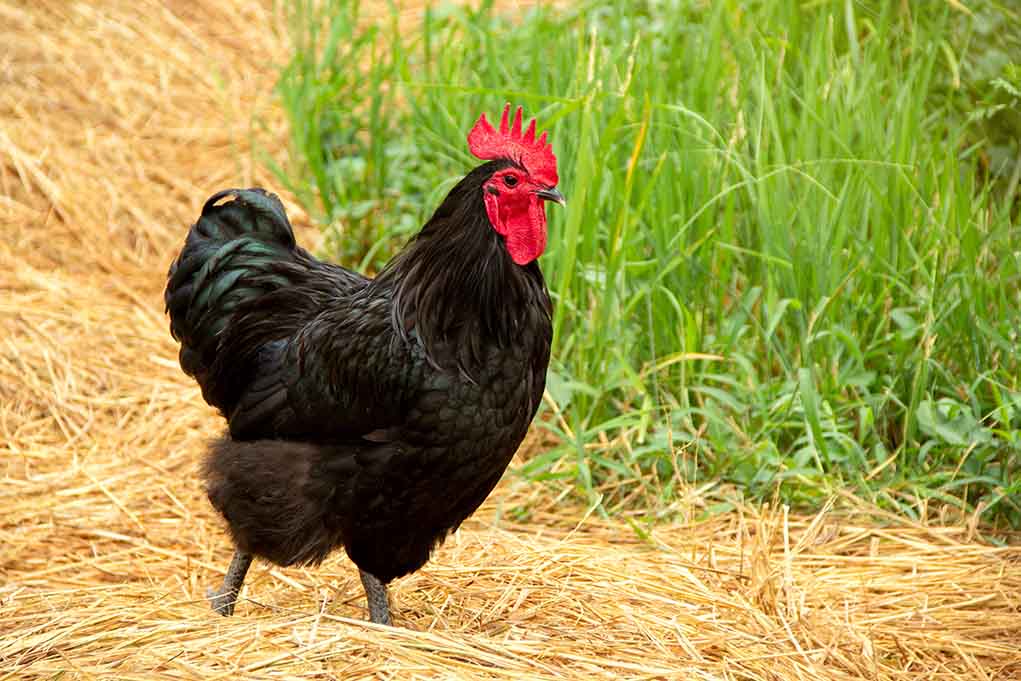Last Updated on July 2, 2021 by Fumipets
The Australorp is a relatively new addition to the chicken world. Despite its short history, it has had a lasting influence on chicken keepers and the poultry industry throughout the world.
The name is a homogenous mixture of the Australian black Orpington. Before it was called Australorp, the breed was known by several distinct names.
Because Australians were responsible for the majority of the breed’s evolution, they have been designated as Australia’s honorary national bird.
This article will look at their temperament, egg-laying abilities, and breed standard, before discussing how to properly care for them and common health concerns.

Overview
| Australorp Chicken | |
|---|---|
| Beginner Friendly: | Yes. |
| Lifespan: | 8+ years. |
| Weight: | 8-10lb. |
| Color: | Black, white, blue and others. |
| Egg Production: | 4-5 per week. |
| Egg Color: | Light brown. |
| Known For Broodiness: | No. |
| Good With Children: | Yes. |
| Cost of Chicken: | $5 per chick. |
History
Australorps has a long and illustrious history, William Cook’s Orpingtons were first transported to Australia in the early 1900s to produce a good dual-purpose bird that would thrive in the Australian environment.
To boost their egg-laying potential, they were crossed with Rhode Island Reds.
The Orpington was being improved in England to produce high-quality meat. Nonetheless, the ever-practical Australian poultry breeders of the 1920s desired an excellent utility bird that produced a lot of eggs as well as secondary meat.
Cook’s Orpingtons were crossed with Rhode Island Reds, Minorcas, White Leghorn, Langshan, and probably Plymouth Rocks for this purpose. The result was a bird that was a great layer, thanks to a mix of Orpington, Leghorn, and Rhode Island Red genes.
Six Australorp chickens lay 1,857 eggs in 1922-1923, an average of 309.5 eggs per bird during a 365-day period.
Farmers staged frequent egg-laying competitions around Australia, and a hen laid 347 eggs in 365 days the next year. The current record is 364 eggs in 365 days, which is an incredible feat, especially given they achieved it without any additional illumination for the chickens.
Because of their robust egg-laying capabilities, the poultry business took interested in them quickly — it was a breed that they didn’t have to pressure into laying.
The Australorp was crossed with the white Leghorn in the 1930s and 1940s, resulting in the Austra White, an even more prolific hen.
The Australorp had a decrease that has been reversed in recent years. It is classified as a resurgent breed. They’re still a top layer now, and they’re perfect for a tiny backyard setting.
They’re popular among backyard chicken keepers for the same reason — and a few more.
They’re also known as Black Australorp (also available in white and blue), Australian Orpington, or Australs.
While initially timid, the Australorp is reputed to be a very sociable large-breed chicken. They’re wonderful for individuals who are interested in fair chickens and create the ideal children’s chicken.

Breed Standard
The Australorp is exclusively recognized by the American Poultry Association in its original colour — black.
The Australian Poultry Society, on the other hand, recognizes black, blue, and white variants.
In addition to the other colours, South Africa has buff, splash, wheaten laced, and golden.
The Australorp is a huge, hefty bird with silky feathers that fit together tightly. It is defined as a heavy-feathered English bird with soft feathers.
Its attitude should be quite firm, with the tail held high. With a deep, strong body, the breast is full and well-rounded. The colour of the wattles, earlobes, and comb should all be red. The comb should be upright with a maximum of seven points.
Feathers should be removed from the legs, which should be black or slate blue in colour. Each foot has four toes, and the skin on the bottom of the foot, like the skin on the rest of the body, should be white. The beak is dark in colour, and the eyes are a gleaming jet black.
The standard-sized birds are large, with a male weighing between 8 and 10 pounds and a hen weighing between 6 and 8 pounds.
Male bantams weigh 2-2.7 pounds, while females weigh 1.7-2.2 pounds.
Temperament and Appearance
In the sunshine, the black Australorp’s feathers have a beetle-green shine, giving them a remarkable colouration.
It walks with a ‘stately’ gait, which it inherited from the Orpington, who glides around the barnyard like a Duchess at a tea party.
They will take confinement well, however, like other heavier, bigger breeds, they will love free-ranging and combing the yard for bugs and tidbits since they like being active.
Because they are slightly prone to obesity if maintained only in confinement, the exercise part of free-ranging is beneficial to them.
They’re a fast-growing breed with a reserved disposition as first, but once they’ve settled in, they’ll probably follow you around the yard if you have any goodies in your pockets!

Egg laying
The Australorp, as previously stated, is an egg-laying machine. Although not as prolific as their progenitors, the contemporary type will produce 250 eggs each year on average. Depending on the hen, individuals may lay more or less eggs.
This works out to about five light brown, medium-sized eggs every week — not bad!
They produce more eggs in an industrial environment because the lighting and feed are precisely managed for optimal output.
Australorps are reputed to be average to good nest sitters and good mothers to their chicks, depending on the line of Australorps you have. Some reports claim that they are bad sitters, but others claim that they are excellent sitters and moms. The number of ‘yes’ appears to outweigh the number of ‘nays.’
Unlike its parent bird, the Orpington, they are ordinary broodiers.
Feeding
The feeding of this breed is fairly simple.
During the laying season, a regular 16 percent layer pellet will suffice. As soon as they reach the age of 18 weeks, you can start them on this meal.
You may increase their protein content in their meals to 18-20% during their molt to help them regenerate their feathers faster without exhausting their protein reserves.
Extra calcium should be provided separately from their meal so that chickens that require it can assist themselves. Calcium should never be mixed with ordinary feed since too much calcium can be just as hazardous as not enough.
If your females are limited to a run, you might want to consider giving them insoluble grit.

Coop Setup
Australorps are huge females that will require at least 4 square feet of space within the coop.
Remember that the more room you have, the better (especially if they are confined). They are not pushy gals, but they do prefer their own personal space, so make sure they have plenty of it.
If you can, offer them each 10 inches of perching space instead of the normal 8 inches of perching area.
Also, give a variety of perches of varying heights so they have a choice of roosting locations.
Finally, standard-sized nesting boxes (12 by 12 inches) will be required.
They won’t be able to share nesting boxes because of their size, but they will be able to sit comfortably for a while. While sharing a nesting box may appear sweet, it might result in soiled or damaged eggs, thus it is not recommended!
Special Needs and Health Issues
This historical breed is strong and healthy. For this laid-back hen, there are no specific considerations. Between 6 and 10 years is the typical life expectancy.
All you need to be concerned about is parasites and other minor poultry concerns.
Because of its very gorgeous black feathering, the Australorp requires constant shade. Despite being a tough species that tolerates heat well, this bird is more prone to heatstroke than other chicken breeds.
Why You Should Get The Australorp
The Australorp is a good choice if you want a hen that is easy to care for, lays a lot of eggs, and blends in nicely with your existing flock.
Although they might be hesitant at first, they will warm up to you and become a pleasant and affectionate barnyard buddy. They, especially the roosters, have a soft and lovely personality, with not a mean bone in their bodies.
They are not a forceful breed, but rather a peaceful and gentle one. They’ll most likely be in the middle of the pack. More aggressive breeds can bully them, so keep a watch on the more obnoxious birds in your flock.
They’re a breed that’s quite easy to handle, which makes them ideal for agricultural programs like 4H in the United States.
They also make good exhibition birds once they’ve gotten acclimated to the noise and commotion, usually earning medals for their owners.
They can withstand a broad range of temperatures and climatic conditions, from hot climes like Australia to colder climes like the American Midwest. In terms of weather, this bird is a true all-rounder.
While the Australorp likes foraging, it is a breed that can be a bit wary of predators. Their black feathers help them blend in in some environments, but they may also cause them trouble in others when they stand out.

Conclusion
The Australorp is a wonderful addition to any flock.
They are a fantastic bird for novices since they don’t require much in the way of special care and are easy to handle because they acclimatize to being handled fast.
It’s a lovely, peaceful bird to have in your flock. They’re neither flighty or loud, are cold resilient, make nice flockmates, and produce a lot of tasty eggs…

















